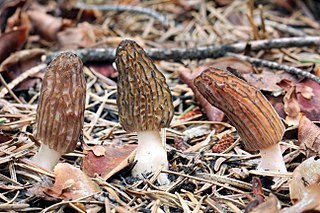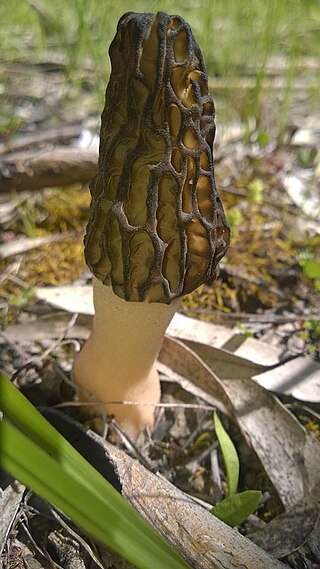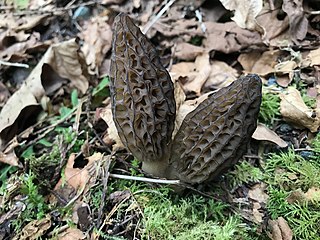
Morchella, the true morels, is a genus of edible sac fungi closely related to anatomically simpler cup fungi in the order Pezizales. These distinctive fungi have a honeycomb appearance due to the network of ridges with pits composing their caps. Morels are prized by gourmet cooks, particularly in Catalan and French cuisine. Due to difficulties in cultivation, commercial harvesting of wild morels has become a multimillion-dollar industry in the temperate Northern Hemisphere, in particular North America, Turkey, China, the Himalayas, India, and Pakistan where these highly prized fungi are found in abundance.

Eucalyptus globulus, commonly known as southern blue gum or blue gum, is a species of flowering plant in the family Myrtaceae. It is a tall, evergreen tree endemic to southeastern Australia. This Eucalyptus species has mostly smooth bark, juvenile leaves that are whitish and waxy on the lower surface, glossy green, lance-shaped adult leaves, glaucous, ribbed flower buds arranged singly or in groups of three or seven in leaf axils, white flowers and woody fruit.

Morchella elata is a species of fungus in the family Morchellaceae. It is one of many related species commonly known as black morels, and until 2012 the name M. elata was broadly applied to black morels throughout the globe. Like most members of the genus, M. elata is a popular edible fungus and is sought by many mushroom hunters.

Margarya bicostata is a species of large operculate freshwater snail, an aquatic gastropod mollusk in the family Viviparidae, the river snails.

Morchella rufobrunnea, commonly known as the blushing morel, is a species of ascomycete fungus in the family Morchellaceae. A choice edible species, the fungus was described as new to science in 1998 by mycologists Gastón Guzmán and Fidel Tapia from collections made in Veracruz, Mexico. Its distribution was later revealed to be far more widespread after several DNA studies suggested that it is also present in the West Coast of the United States, Israel, Australia, Cyprus, Malta and Switzerland.

Morchella semilibera, commonly called the half-free morel, is an edible species of fungus in the family Morchellaceae native to Europe and Asia.

Morchella tridentina is a cosmopolitan species of ascomycete fungus in the family Morchellaceae. Commonly referred to as the mountain blond or western blond morel in North America, it produces conical, grey to buff fruit bodies that are rufescent and grow up to 20 cm (7.9 in) tall and 5 cm (2.0 in) wide. This early-diverging species is distinct within the /Elata clade due to its pale colours and has been described by many names in the past, including M. frustrata, M. quercus-ilicis, M. elatoides, M. elatoides var. elegans and M. conica var. pseudoeximia, all of which were shown to be synonyms. A widely distributed relict of the last Ice Age, M. tridentina is so far known from Argentina, Armenia, Chile, Cyprus, France, India, Israel, North America, Spain and Turkey.

Morchella importuna is a species of fungus in the family Morchellaceae described from North America in 2012. It occurs in gardens, woodchip beds, and other urban settings of northern California and the Pacific Northwest region of the United States and Canada. The fungus has also been reported from Turkey, Spain, France, Switzerland, Canada and China, although it is unknown whether this is a result of accidental introductions. It is considered a choice edible mushroom. The fruit bodies develop a distinctive ladder-like pattern of pits and ridges on the surface of their conical caps.
Morchella capitata is a later synonym of Morchella exuberans. Originally identified as phylogenetic species Mel-9, it was described as new to science in 2012 by Kuo and colleagues. In 2014 however, Richard and colleagues clarified the taxonomic status of this species, retaining the name Morchella exuberans of Clowez (2012) over M. capitata.

Morchella septimelata is a species of fungus in the family Morchellaceae described as new to science in 2012. Occurring in western North America, it has been collected from British Columbia, Montana and Oregon, where it fruits at elevations of 1,000 to 2,000 m in coniferous forests in years following slight to moderate burning.

Morchella sextelata is a species of ascomycete fungus in the family Morchellaceae. Described as new to science in 2012, it is found in North America. It has also been found in China, although it is not known if this is a result of an accidental introduction or natural dispersion. The fruit bodies have a roughly conical cap up to 7.5 cm (3 in) tall and 5 cm (2 in) wide, with a surface of mostly vertically arranged pits. The cap is initially yellowish to brownish, but it darkens to become almost black in maturity. The stipe is white and hollow, measuring 2–5 cm (0.8–2.0 in) high by 1–2.2 cm (0.4–0.9 in) wide.
Morchella deqinensis is a species of fungus in the family Morchellaceae found in China. It grows in coniferous and mixed forests at an elevation of 2,800–3,200 m (9,200–10,500 ft).
Morchella meiliensis is a species of fungus in the family Morchellaceae native to China.

Morchella australiana is a species of ascomycete fungus in the family Morchellaceae. Described as new to science in 2014, it is found in New South Wales, South Australia,Tasmania and Victoria, Australia. The type locality was in the temperate Pilliga Scrub of northwestern New South Wales, west of the Great Dividing Range. Fruit bodies of the fungus resemble those of the European Morchella elata, but molecular and morphological analyses demonstrated that the Australian species represents a unique lineage.

Morchella anatolica is a rare species of ascomycete fungus in the family Morchellaceae. It was described as new to science in 2010 from southwest Anatolia, Turkey, where it grows on moss-covered stream beds in pine forests. An ancient climatic relict, M. anatolica is restricted to the Mediterranean basin and has also been documented in Spain, Cyprus and Greece, where it is sometimes encountered with trees of the Oleaceae family. Together with its sister-species Morchella rufobrunnea, they are the earliest diverging lineages in genus Morchella, forming a distinct clade that is basal in global morel phylogenies. Because of its phylogenetic position, M. anatolica has been crucial in inferring the historical biogeography of the genus, which is estimated to have emerged somewhere in the Mediterranean region in the late Jurassic.

Morchella galilaea is a species of fungus in the family Morchellaceae that was described as new to science in 2012. Unlike most morels, which are characterized by spring season fruiting, M. galilaea fruits in autumn. Molecular studies have shown that the fungus is found in China, Java, Hawaii, Israel, New Zealand, India, Turkey, and three countries in Africa. The type collection was made under Fraxinus syriaca plants in Israel.
Morchella palazonii is a species of morel found in Spain.
Morchella kakiicolor is a species of fungus in the family Morchellaceae (Ascomycota). It was originally proposed as a form of Morchella quercus-ilicis in a 2012 study by Philippe Clowez, but was later re-combined as an autonomous species by Loizides and colleagues, based on molecular phylogenetic data. In the same study, M. quercus-ilicis f. quercus-ilicis was shown by the authors to be a later synonym of the old taxon Morchella tridentina, and not phylogenetically related to M. kakiicolor.

Morchella eohespera is a species of fungus in the family Morchellaceae described as new to science in 2016. In North America, it has been collected from Newfoundland and Labrador, New Brunswick, British Columbia, Canada and in Washington state. It is also found in central and northern Europe, and central China. It is in the Morchella elata clade.
Morchella exuberans is a species of fungus in the family Morchellaceae (Ascomycota). It was described as new to science in a 2012 study by Clowez and corresponds to phylogenetic lineage Mel-9. Morchella capitata, described by Kuo and colleagues later in the same year, is a synonym of this taxon.













